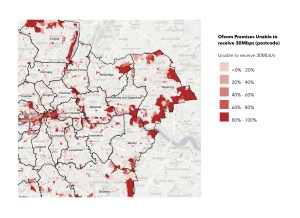Press Unencumber
Over 150,000 premises in south and east London don’t have get admission to to prime velocity – Gigabit succesful – web connections
Opposite to belief, loads of 1000’s of addresses in London are suffering from sluggish virtual connectivity, inflicting virtual inequalities that hinder the lives of other folks and companies.
The ‘Sub-regional Virtual Infrastructure Technique’ introduced these days via Native London and the South London Partnership, identifies gaps in 14 south and east London boroughs. It comprises suggestions for riding up the standard and accessibility of services and products in them and can assist channel funding to spaces of financial alternative.
There are over 103,000 premises in Native London and 53,000 South London Partnership not able to acquire a Gigabit succesful broadband carrier with many sitting in a ‘now not spot,’ not able to obtain even a 30 Mbps carrier.

Mapping out the digitally deficient postcodes, the tactic highlights perfect practices, studying and movements that the private and non-private sector can take in combination to construct world-leading virtual infrastructure for one of the quickest rising portions of London.
Commissioned via the Mayor of London’s Infrastructure Coordination Carrier, the ‘Sub-regional Virtual Infrastructure Technique’ is a part of a much broader pilot which is able to ship an interactive mapping software and an on-line virtual toolkit that can lend a hand borough officials to ship virtual infrastructure to their websites and leverage further industrial virtual infrastructure funding within the sub-regions.
The ‘Sub-regional Virtual Infrastructure Technique’ supplies a compelling argument for actively pursuing virtual funding at the side of step by step steering to public sector officials to draw funding and advertise higher high quality and extra obtainable services and products, together with:
- Map and statistics illustrating obviously the place deficient virtual infrastructure problems lie.
- Suggestions for public sector resourcing and roles, business engagement, procurement choices and industrial fashions, and key elements of a a hit supply technique.
- Case research and examples from throughout the United Kingdom demonstrating a hit techniques of running and advantages received.
- The strategic, industrial, monetary, control case and choices research.

Theo Blackwell MBE, Leader Virtual Officer, Better London Authority stated “Broadly to be had, simply obtainable virtual connectivity is very important for other folks to achieve public services and products and is essential to serving to towns develop via riding innovation and the advent of recent companies.
“But there are nonetheless portions of London that be afflicted by a loss of industrial funding in virtual infrastructure, and this leads to gaps in web protection or ‘now not spots’.
“We will have to deal with those gaps and force the up the standard and accessibility of the services and products which are already to be had, to assist the capital to be a fairer, extra wealthy, and extra equivalent London for everybody.”
Cllr Baroness O’Neill of Bexley OBE, Chairman of Native London and Chief of London Borough of Bexley stated “We’re extremely joyful to release the ‘Sub-regional Virtual Infrastructure Technique’ with our colleagues at South London Partnership. This gives step by step steering to public sector colleagues for unlocking inward funding and maximising present infrastructure to learn other folks and companies within the house. Together with the database and virtual toolkit, this pilot way will assist all 14 boroughs take on the virtual divide, while additionally making a legacy of studying that experience even wider advantages.”
Cllr Gareth Roberts, Chair, South London Partnership and Chief of London Borough of Richmond upon Thames Council commented “This joint technique demonstrates some great benefits of a cross-boundary way. Addressing the problems at a sub-regional stage, with colleagues at Native London, this technique supplies transparent steering for unlocking speedy deployment of subsequent era wi-fi infrastructure and gigabit succesful complete fibre, to align us with different city spaces in the United Kingdom, while responding to the distinct social and financial wishes of every borough.”
